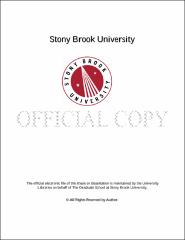| dc.identifier.uri | http://hdl.handle.net/11401/76333 | |
| dc.description.sponsorship | This work is sponsored by the Stony Brook University Graduate School in compliance with the requirements for completion of degree. | en_US |
| dc.format | Monograph | |
| dc.format.medium | Electronic Resource | en_US |
| dc.language.iso | en_US | |
| dc.publisher | The Graduate School, Stony Brook University: Stony Brook, NY. | |
| dc.type | Thesis | |
| dcterms.abstract | Deep etch is always a challenge in semiconductor industry due to the requirement of high selectivity and fidelity for the process. Atomic layer deposition (ALD) is a new thin film deposition technique which is self-limiting and provides excellent conformality and reproducibility. Other than the application of deposition, ALD also provides an approach which operates at semi-static mode to modify the characteristic of the bulk of resist, which will render a high resistance to plasma etch as well as sidewall protection. In this research, etching resistance of two types of e-beam resists and two types of photoresists is treated by sequential infiltration synthesis (SIS). Resist patterns are sequentially exposed to trimethyl aluminum (TMA) precursor and water vapor which form alumina in the bulk, providing a high resistance under several plasma etching processes. A specially designed sample architecture is used to characterize the etching properties. During the infiltration process, the top surface of resist is cover with germanium to prevent diffusion, which presents alumina density variation on vertical direction. By observing the cross section profile after etching, the infiltration property can be analyzed. The resistance of S1811, ma-N 1410, PMMA are greatly enhanced, that of ZEP520 is also slightly improved. A hypothesis about the principle of SIS is proposed that the bond may become saturated within the first cycle of SIS, which blocks the following diffusion of gaseous precursors. | |
| dcterms.available | 2017-09-20T16:50:02Z | |
| dcterms.contributor | Meng, Yizhi | en_US |
| dcterms.contributor | Lu, Ming | en_US |
| dcterms.contributor | Venkatesh, T. A.. | en_US |
| dcterms.creator | Meng, Xianghai | |
| dcterms.dateAccepted | 2017-09-20T16:50:02Z | |
| dcterms.dateSubmitted | 2017-09-20T16:50:02Z | |
| dcterms.description | Department of Materials Science and Engineering. | en_US |
| dcterms.extent | 69 pg. | en_US |
| dcterms.format | Application/PDF | en_US |
| dcterms.format | Monograph | |
| dcterms.identifier | http://hdl.handle.net/11401/76333 | |
| dcterms.issued | 2013-12-01 | |
| dcterms.language | en_US | |
| dcterms.provenance | Made available in DSpace on 2017-09-20T16:50:02Z (GMT). No. of bitstreams: 1
Meng_grad.sunysb_0771M_11423.pdf: 4230886 bytes, checksum: c854921c09fc8ded62143c6e21f7ac74 (MD5)
Previous issue date: 1 | en |
| dcterms.publisher | The Graduate School, Stony Brook University: Stony Brook, NY. | |
| dcterms.subject | atomic layer deposition, plasma etch resistance, sequential infiltration synthesis | |
| dcterms.subject | Materials Science | |
| dcterms.title | Study on improvement of plasma etch resistance of photo resists and e-beam resists by sequential infiltration synthesis | |
| dcterms.type | Thesis | |

